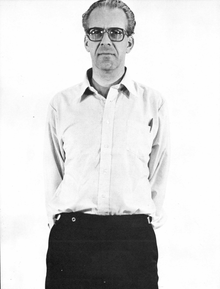Maarten Schmidt
Maarten Schmidt (born December 28, 1929) is a Dutch astronomer who measured the distances of quasars.
Maarten Schmidt | |
|---|---|
 Maarten Schmidt in 1978 | |
| Born | December 28, 1929 Groningen |
| Nationality | Dutch |
| Alma mater | Leiden Observatory |
| Known for | quasars |
| Awards | Karl Schwarzschild Medal (1968) Kavli Prize (2008)[1] |
| Scientific career | |
| Fields | astronomy |
| Institutions | California Institute of Technology |
| Doctoral advisor | Jan Oort |
Born in Groningen, The Netherlands,[2] Schmidt studied with Jan Hendrik Oort. He earned his Ph.D. degree from Leiden Observatory in 1956. He was a co-recipient, with Donald Lynden-Bell, of the inaugural Kavli Prize for Astrophysics in 2008.[1]
In 1959, he emigrated to the United States and went to work at the California Institute of Technology. In the beginning, he worked on theories about the mass distribution and dynamics of galaxies. Of particular note from this period was his formulation of what has become known as the Schmidt law, which relates the density of interstellar gas to the rate of star formation occurring in that gas.[3][4] He later began a study of the light spectra of radio sources. In 1963, using the 200-inch reflector telescope at the Palomar Observatory, Schmidt identified the visible object corresponding to one of these radio sources, known as 3C 273 and also studied its spectrum. While its star-like appearance suggested it was relatively nearby, the spectrum of 3C 273 proved to have what was at the time a high redshift of 0.158, showing that it lay far beyond the Milky Way, and thus possessed an extraordinarily high luminosity. Schmidt termed 3C 273 a "quasi-stellar" object or quasar; thousands have since been identified.
Honors
Awards
- Helen B. Warner Prize (1964)
- Front cover of Time March 11, 1966 [5]
- Henry Norris Russell Lectureship (1978)
- Gold Medal of the Royal Astronomical Society (1980)
- Golden Plate Award of the American Academy of Achievement (1980)[6]
- Correspondent of the Royal Netherlands Academy of Arts and Sciences (1980)[7]
- James Craig Watson Medal (1991)
- Bruce Medal (1992)
- Kavli Prize for Astrophysics (2008)[1]
- Member of the Norwegian Academy of Science and Letters.[8]
Named after him
- Asteroid 10430 Martschmidt
References
- "2008 Kavli Prize Laureates in Astrophysics". www.kavliprize.org. 28 August 2008.
- "The Rumford Prize". Bulletin of the American Academy of Arts and Sciences. American Academy of Arts & Sciences. 22 (3): 8–9. January 1969. JSTOR 3822873.
- Schmidt, Maarten (1959). "The Rate of Star Formation". The Astrophysical Journal. 129: 243. Bibcode:1959ApJ...129..243S. doi:10.1086/146614.
- Kennicutt, Robert C. (1998). "The global Schmidt law in star-forming galaxies". The Astrophysical Journal. 498 (2): 541–552. arXiv:astro-ph/9712213. Bibcode:1998ApJ...498..541K. doi:10.1086/305588.
- "Maarten Schmidt - Mar. 11, 1966". Time.
- "Golden Plate Awardees of the American Academy of Achievement". www.achievement.org. American Academy of Achievement.
- "M. Schmidt". Royal Netherlands Academy of Arts and Sciences. Retrieved 3 August 2015.
- "Gruppe 2: Fysikkfag (herunder astronomi, fysikk og geofysikk)" (in Norwegian). Norwegian Academy of Science and Letters. Retrieved 7 October 2010.
External links